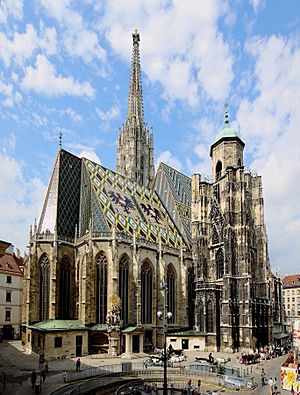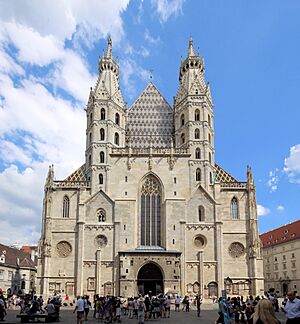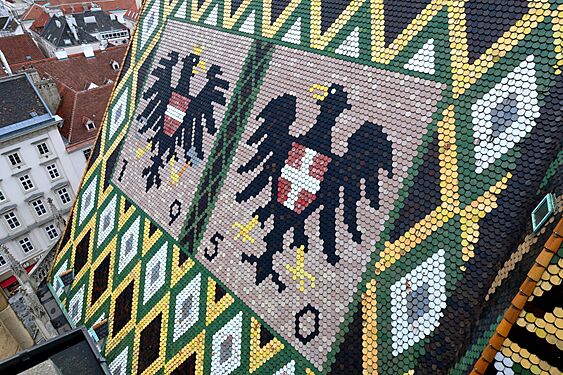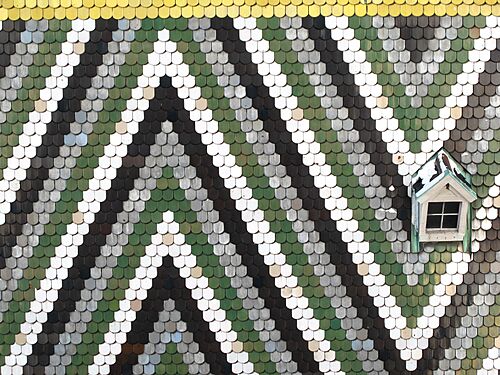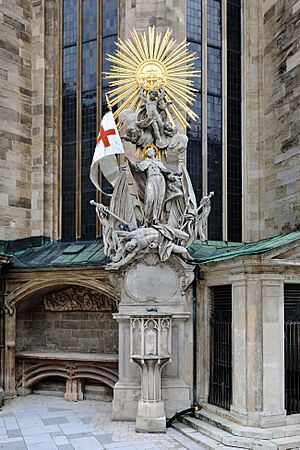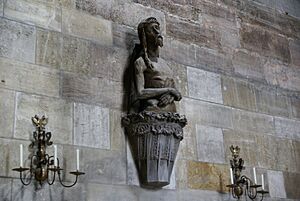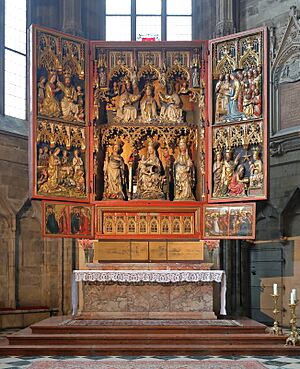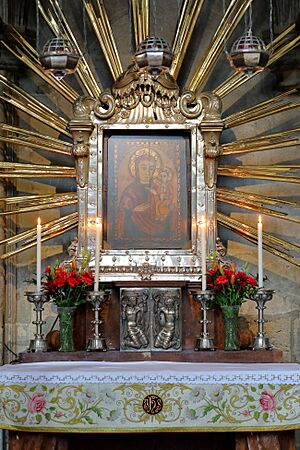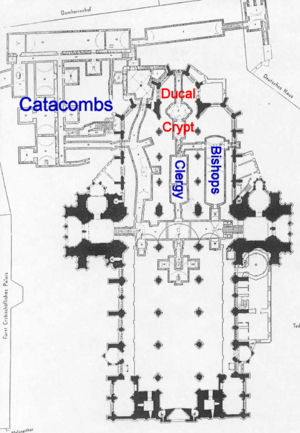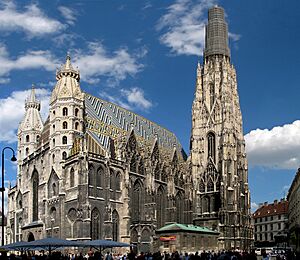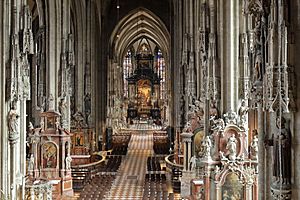St. Stephen's Cathedral, Vienna facts for kids
Quick facts for kids St. Stephen's Cathedral |
|
|---|---|
| Cathedral and Metropolitan Church of Saint Stephen and All Saints | |
 |
|
| 48°12′31″N 16°22′23″E / 48.2085°N 16.373°E | |
| Location | Vienna |
| Country | Austria |
| Denomination | Roman Catholic |
| History | |
| Status | Cathedral (also parish church) |
| Architecture | |
| Functional status | Active |
| Style | Romanesque, Gothic |
| Groundbreaking | 1137 |
| Completed | 1578 |
| Specifications | |
| Length | 107 metres (351 ft) |
| Width | 70 metres (230 ft) |
| Nave width | 38.9 metres (128 ft) |
| Height | 136.7 metres (448 ft) |
| Number of spires | 2 main |
| Spire height | North: 68.3 metres (224 ft) South: 136.44 metres (447.6 ft) |
| Materials | limestone |
| Bells | 22 |
| Administration | |
| Archdiocese | Vienna |
St. Stephen's Cathedral (called Stephansdom in German) is a famous Catholic church in Vienna, Austria. It is the main church for the Archdiocese of Vienna and where the Archbishop of Vienna, Christoph Cardinal Schönborn, leads services.
The church you see today, with its Romanesque and Gothic styles, was mostly started by Duke Rudolf IV in the 1300s. It was built on the remains of two older churches. St. Stephen's Cathedral is Vienna's most important religious building. It has seen many important moments in Austrian history and its colorful tiled roof makes it one of the city's most recognizable symbols. You can climb 256 stairs to reach the top!
Contents
History of St. Stephen's Cathedral
By the mid-1100s, Vienna was growing fast, and the city needed more churches. In 1137, a treaty was signed that set aside land for a new parish church. This church would eventually become St. Stephen's Cathedral. It was likely built on an ancient cemetery, with graves dating back to the 4th century.
Building the Cathedral: From Romanesque to Gothic
The first church structure was dedicated in 1147 to Saint Stephen. Important people like Conrad III of Germany were there. The first building was finished in 1160, but major construction and repairs have continued ever since.
From 1230 to 1245, the original Romanesque church was made bigger. The current west wall and two Romanesque towers are from this time. In 1258, a big fire destroyed much of the building. A new, larger Romanesque church was built on its ruins and opened in 1263. Each year, the huge Pummerin bell rings for three minutes to remember this day.
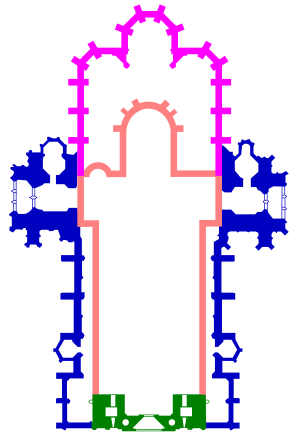
In 1304, King Albert I ordered a new Gothic choir section to be built. His son, Duke Albert II, continued this work, and the Albertine choir was dedicated in 1340. The main part of the choir is for St. Stephen and All Saints, while the side parts are for St. Mary and the Apostles.
Duke Rudolf IV wanted Vienna to be even more important. In 1359, he started a new Gothic expansion towards the west. This new part would eventually cover the entire old church. By 1430, the old church building was removed from inside the new, growing cathedral. The south tower was finished in 1433. Work on the main part of the church continued until 1474. A north tower was started in 1450 but was never finished.
Becoming a Diocese and Surviving War
In 1365, Duke Rudolf IV wanted St. Stephen's to be more than just a parish church. He created a group of canons (priests) for it, like a big cathedral. This was the first step for Vienna to get its own diocese (a church district led by a bishop). In 1469, Emperor Frederick III convinced the Pope to give Vienna its own bishop. St. Stephen's Cathedral became the main church for this new diocese. Later, in 1722, it became an archbishopric, meaning it was even more important.
During World War II, the cathedral was almost destroyed by retreating German forces. Luckily, a German captain ignored orders to blow it up. However, in April 1945, fires started by looters spread to the cathedral. The roof was badly damaged and collapsed. Thankfully, protective brick walls had been built around important artworks, saving them. The church was quickly rebuilt after the war, reopening fully in 1952.
Outside the Cathedral
The cathedral is built from limestone and is 107 meters (351 feet) long, 40 meters (131 feet) wide, and 136 meters (446 feet) tall at its highest point. Over time, pollution has made the stone look black, but recent cleaning projects are bringing back its original white color.
Cathedral Towers
The massive south tower is 136 meters (446 feet) tall. Locals lovingly call it "Steffl," a nickname for Stephen. Its construction took 65 years, from 1368 to 1433. During sieges in 1529 and 1683, it was used as a lookout post to defend Vienna. Until 1955, watchmen lived in the tower and rang bells if they saw a fire. At the very top, you can see the double-eagle symbol of the old Habsburg empire.
The north tower was meant to be as tall as the south tower, but the project was too big for the time. Construction stopped in 1511. In 1578, a Renaissance-style cap was added, which Viennese people call the "water tower top." This tower is now about 68 meters (223 feet) tall, half the height of the south tower.
The main entrance is called the Giant's Door, or Riesentor. This name might come from a mammoth bone that hung above it for many years, or from an old German word meaning "funnel-shaped." Above the door, there's a carving of Christ with two angels. On either side are the two Roman Towers, or Heidentürme, which are about 65 meters (213 feet) tall. These towers are called "Roman" because they were built using stones from old Roman buildings. They are the oldest parts of the church, along with the Giant's Door.
The Colorful Roof
The roof of St. Stephen's Cathedral is very special. It is 111 meters (364 feet) long and covered with 230,000 glazed tiles. On the south side, the tiles form a mosaic of the double-headed eagle, a symbol of the Habsburg empire. On the north side, you can see the coats of arms of Vienna and Austria.
In 1945, a fire destroyed the wooden frame of the roof. Instead of wood, over 600 tons of steel were used to rebuild it. The roof is so steep that rain keeps it clean, and snow rarely stays on it.
Cathedral Bells
St. Stephen's Cathedral has 22 bells in four different bell towers.
The Pummerin Bell
The largest bell is called Marienglocke (St. Mary's Bell), but everyone knows it as Pummerin (meaning "Boomer") because of its deep sound. It weighs over 20,000 kilograms (44,000 pounds) and is 3.14 meters (10.3 feet) wide. It's the biggest bell in Austria and the third largest swinging bell in Europe.
The Pummerin usually rings on very special days like Easter, Christmas Eve, and New Year's Day. The current Pummerin was cast in 1951 after the original "Old Pummerin" was destroyed in the 1945 fire. The old bell was made in 1705, partly from cannons captured from the Ottoman Empire. When the fire hit in 1945, the old bell fell and shattered. Its pieces were used to make the new Pummerin.
Bells in the South Tower
The south tower has 13 bells. Eleven of these are used for traditional ringing. They were made in 1960 to replace bells lost in the 1945 fire. The largest of these is the Stephanusglocke (Bell of St. Stephen), which is second in size only to the Pummerin. These bells ring in special patterns for Mass, holidays, and other important church events. For example, the Stephanusglocke rings when the archbishop of Vienna is at the cathedral.
The other two bells in the south tower are clock bells. The Primglocke chimes every 15 minutes, and the Uhrschälle strikes the hour.
Bells in the Romanesque Towers
The northern Romanesque tower has seven bells. These bells were once used for city functions, but now they are mostly used for evening prayers. The Feuerin (fire alarm) rings every Thursday evening to remember the last moments of Jesus Christ. The Churpötsch rings on Saturdays after the evening Angelus prayer.
In 2017, the Chorglöckl, made around 1280, was added to this tower. It's the oldest bell in the cathedral and rings every Friday evening to remember those who died that week. The Zügenglocke was also moved here in 2022 and encourages prayers for people who are close to death.
Outside Wall Features
In the Middle Ages, cities had their own ways of measuring things. On the cathedral wall, to the left of the main entrance, you can still see two iron bars. These were the official Viennese standards for measuring cloth.
A special plaque (near SJC on the map) tells about Wolfgang Amadeus Mozart's connection to the cathedral. He was a music director here, got married here, had two of his children baptized here, and his funeral was held in the Chapel of the Cross inside.
Next to the entrance to the catacombs is the Capistran Chancel. This is an outdoor pulpit (at SJC) where St. John Capistrano preached in 1456, encouraging people to fight against invasions. The statue shows him stepping on a defeated Turk. This was the main pulpit inside the cathedral until 1515.
There's a statue of Christ (at CT) that Viennese people affectionately call "Christ with a toothache." At the southwest corner (S), you can see old memorials from when the area was a cemetery. There's also a restored 15th-century sundial on a flying buttress.
Inside the Cathedral
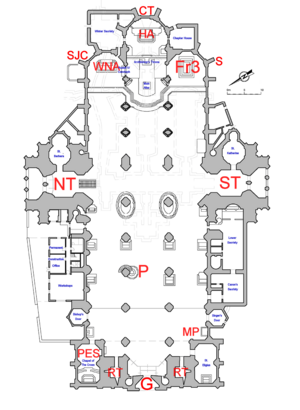
Altars in the Cathedral
The main part of the church has 18 altars, plus more in different chapels. The most famous are the High Altar (HA) and the Wiener Neustadt Altar (WNA).
The High Altar was built between 1641 and 1647. It shows the stoning of St. Stephen, the church's patron saint. Around it are statues of other saints, and above it, a statue of St. Mary points towards heaven, where Christ waits for St. Stephen.
The Wiener Neustadt Altar is at the front of the north part of the church. It was ordered in 1447 by Emperor Frederick III, whose tomb is nearby. This altar is made of two parts. When the lower panels are open, they show beautiful gilded wooden figures of events in the life of the Virgin Mary. When closed, they show 72 saints. This altar was restored over 20 years, finishing in 2005.
The Máriapócs Icon
The Maria Pötsch Icon (MP) is a painting of St. Mary and baby Jesus in a Byzantine style. It came from a Hungarian village called Máriapócs. The painting shows Mary pointing to Jesus, and Jesus holding a three-stemmed rose, which symbolizes the Holy Trinity.
In 1696, people claimed the mother in the painting shed real tears twice. Because of this, Emperor Leopold I ordered it brought to St. Stephen's Cathedral in 1697 to keep it safe. It was placed near the High Altar. Many people, especially Hungarians, still light candles and pray before it. Since it arrived in Vienna, the icon has not been seen weeping again, but other miracles and answered prayers have been linked to it.
The people of Máriapócs wanted their special painting back, so the emperor sent them a copy. It is said that this copy also started weeping tears and working miracles, so the village changed its name to Máriapócs and became an important place for pilgrimages.
The Pulpit
The stone pulpit is a masterpiece of late Gothic sculpture. It's thought that Niclaes Gerhaert van Leyden carved it. To help people hear the sermon better before microphones existed, the pulpit is placed against a pillar in the main part of the church, not at the very front.
The sides of the pulpit look like petals and have carved portraits of four important church teachers: St. Augustine of Hippo, St. Ambrose, St. Gregory the Great, and St. Jerome. The handrail of the stairs leading up to the pulpit has carvings of toads and lizards biting each other, which symbolizes the fight between good and evil. At the top of the stairs, a stone puppy seems to guard the preacher.
Beneath the stairs, there's a famous stone self-portrait of the unknown sculptor. He's peeking out of a window, and this carving is known as the Fenstergucker (Window-peeker). The chisel in his hand and his mark suggest it's him.
Cathedral Chapels
St. Stephen's Cathedral has several chapels:
- St. Catherine's Chapel: Located at the base of the south tower, this is where baptisms take place. The baptismal font was finished in 1481.
- St. Barbara's Chapel: At the base of the north tower, used for quiet prayer.
- St. Eligius's Chapel: In the southeast corner, open for prayer. Its altar is dedicated to St. Valentine.
- St. Bartholomew's Chapel: Above St. Eligius' Chapel, recently restored.
- The Chapel of the Cross (PES): In the northeast corner, this chapel holds the burial place of Prince Eugene of Savoy. Mozart's funeral was held here in 1791. The beard on the crucified Christ statue above the altar is made of real hair. This chapel is not open to the public.
- St. Valentine's Chapel: Above the Chapel of the Cross, this chapel stores hundreds of relics from the cathedral, including a piece of the tablecloth from the Last Supper. It also holds the bones of St. Valentine.
Tombs and Catacombs
For centuries, people have been buried inside and around the cathedral. Being buried inside was a great honor.
Inside the cathedral, you can find the tombs of Prince Eugene of Savoy (PES), a military commander, and Frederick III, Holy Roman Emperor (Fr3). Emperor Frederick's tomb is very impressive. It took over 45 years to build and is made of a dense red marble-like stone. The tomb lid shows the Emperor in his royal clothes, surrounded by the coats of arms of his lands.
When the cemeteries around the cathedral closed in 1735 due to an outbreak of bubonic plague, the bones were moved to the catacombs below the church. People were buried directly in the catacombs until 1783. Today, the remains of over 11,000 people are in the catacombs, which you can tour.
The cathedral's basement also has crypts for bishops, provosts, and dukes. The Ducal Crypt holds 78 bronze containers with the bodies, hearts, or other organs of 72 members of the Habsburg royal family. Duke Rudolf IV ordered this crypt built for his remains before he died in 1365.
Organs of St. Stephen's Cathedral
St. Stephen's Cathedral has a long history of organs. The first organ was mentioned in 1334. After the 1945 fire, a large electric organ with 125 stops was built in 1960. In 1991, a smaller mechanical organ was built for the choir.
The large organ at the west end was used for about 35 years before it fell into disuse. From 2017 to 2020, it was rebuilt using parts of the old organ. It now has 5 manuals and 130 stops. There is also a special console that can play both the large west organ and the choir organ at the same time. The cathedral also has three smaller organs.
Keeping the Cathedral Beautiful
Keeping St. Stephen's Cathedral in good condition has been an ongoing job since it was first built in 1147. The limestone used to build it can wear away over time.
The permanent Dombauhütte (Construction Department) uses modern science to repair the cathedral. They even use lasers to clean delicate stone carvings. They are also looking into ways to protect the stone from water damage.
A big project recently finished was renovating the tall south tower. Most of the scaffolding was removed by December 2008. The inside of the cathedral is also being cleaned section by section. An outdoor relief sculpture of Christ in Gethsemane has also been restored.
A major improvement for visitors and worshippers is better heating in the winter. Old heating systems would leave soot on the artwork. The new system uses many different heaters to keep the church warm without damaging the art. The church is now heated to about 10°C (50°F).
Some of the original architectural drawings from the Middle Ages are 15 feet long and very fragile. Now, the cathedral has a digital 3D model made from laser measurements. This helps the nine full-time stonemasons on staff to repair or replace worn-out stonework.
In November 2019, art historians found a mural under layers of dirt in what is now the cathedral's gift shop. They believe it might be a work by the famous Renaissance artist Albrecht Dürer.
Famous People and Events
Many important people in Austrian and European history have had their weddings and funerals at St. Stephen's Cathedral.
- Weddings of royalty: Louis II of Hungary and Mary of Austria (1515); Ferdinand I, Holy Roman Emperor and Anne of Bohemia and Hungary (1515).
- Weddings of musicians: Joseph Haydn (1760); Wolfgang Amadeus Mozart (1782). Mozart's funeral in 1791 was held in the Chapel of the Holy Cross.
- Funeral of Antonio Vivaldi (1741).
- Funerals of members of the House of Habsburg: Franz Joseph I of Austria (1916), who was Emperor during World War I; Zita of Bourbon-Parma (1989), the last Empress of Austria; Otto von Habsburg (2011), the last Crown-Prince of Austria-Hungary.
- Funerals of European royalty: Matthias Corvinus, King of Hungary.
- Funerals of politicians: Thomas Klestil (2004), former president of Austria; Kurt Waldheim (2007), former president of Austria and Secretary-General of the United Nations.
- Funeral of Niki Lauda (2019), a famous Formula One world champion.
Some notable people buried in the crypts include:
- Johannes Cuspinian – an Austrian historian and diplomat.
- Neidhart von Reuental – a medieval German poet and singer.
- Former archbishops of Vienna.
Balassi Mass
Since 2008, two special swords for the Balint Balassi Memorial Sword Award have been blessed during a Balassi Mass at the cathedral. In 2013, a bishop blessed the swords during a Mass attended by many Hungarians.
Images for kids
See also
 In Spanish: Catedral de San Esteban (Viena) para niños
In Spanish: Catedral de San Esteban (Viena) para niños
- List of tallest churches
- Stephansplatz, Vienna
- List of Gothic Cathedrals in Europe
- List of tallest structures built before the 20th century
- Megalothorax sanctistephani



